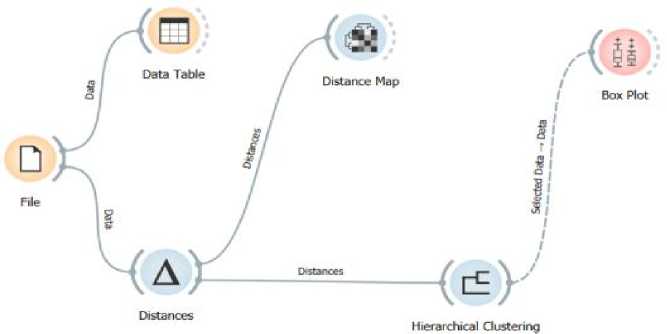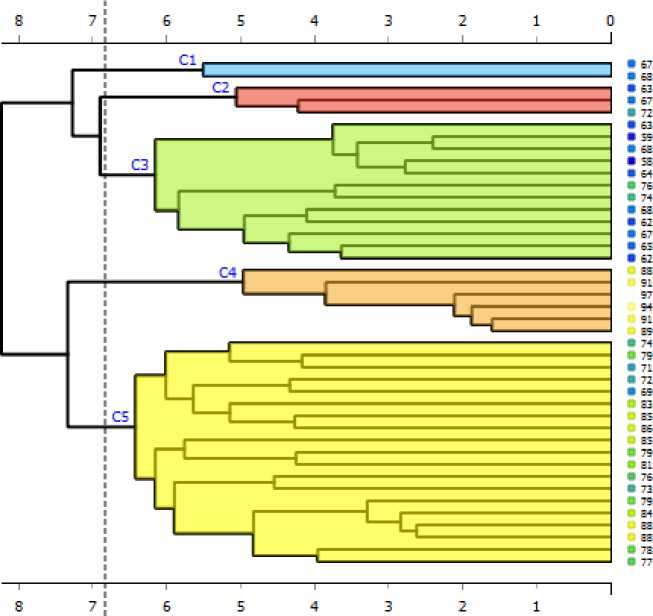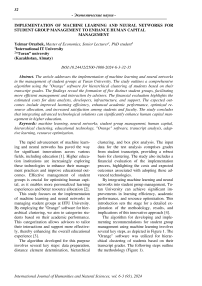Implementation of machine learning and neural networks for student group management to enhance human capital management
Автор: Yelmar O.
Журнал: Международный журнал гуманитарных и естественных наук @intjournal
Рубрика: Экономические науки
Статья в выпуске: 6-3 (93), 2024 года.
Бесплатный доступ
The article addresses the implementation of machine learning and neural networks in the management of student groups at Turan University. The study outlines a comprehensive algorithm using the "Orange" software for hierarchical clustering of students based on their transcript grades. The findings reveal the formation of five distinct student groups, facilitating more efficient management and interaction by advisors. The financial evaluation highlights the estimated costs for data analysts, developers, infrastructure, and support. The expected outcomes include improved learning efficiency, enhanced academic performance, optimized resource allocation, and increased satisfaction among students and faculty. The study concludes that integrating advanced technological solutions can significantly enhance human capital management in higher education.
Machine learning, neural networks, student group management, human capital, hierarchical clustering, educational technology, "orange" software, transcript analysis, adaptive learning, resource optimization
Короткий адрес: https://sciup.org/170205467
IDR: 170205467 | DOI: 10.24412/2500-1000-2024-6-3-32-35
Текст научной статьи Implementation of machine learning and neural networks for student group management to enhance human capital management
The rapid advancement of machine learning and neural networks has paved the way for significant innovations across various fields, including education [1]. Higher education institutions are increasingly exploring these technologies to enhance their management practices and improve educational outcomes. Effective management of student groups is crucial for optimizing human capital, as it enables more personalized learning experiences and better resource allocation [2].
This study focuses on the implementation of machine learning and neural networks in managing student groups at IITU University. By employing the "Orange" software for hierarchical clustering, we aim to categorize students based on their academic performance. This categorization allows advisors to tailor their interactions and support more effectively, thereby enhancing the overall educational experience [3].
The algorithm developed for this purpose involves several key steps: data preparation, distance element determination, hierarchical clustering, and box plot analysis. The input data for the test analysis comprises grades from student transcripts, providing a robust basis for clustering. The study also includes a financial evaluation of the implementation process, highlighting the costs and expected outcomes associated with adopting these advanced technologies.
By integrating machine learning and neural networks into student group management, Turan University can achieve significant improvements in learning efficiency, academic performance, and resource optimization. This introduction sets the stage for a detailed exploration of the methodology, results, and implications of this innovative approach [4].
The algorithm for developing and implementing recommendations for student group management using machine learning involves several key steps, as depicted in Figure 1. The "Orange" software was utilized for hierarchical clustering of students based on their transcript grades. The following steps outline the methodology (Figure 1).

Fig. 1. Algorithm for using the Orange software for hierarchical clustering of students
-
1 . Data Preparation: The grades from student transcripts were collected and prepared for analysis.
-
2 . Distance Element Determination: Appropriate distance metrics were selected to measure the similarity between students' grades.
-
3 . Hierarchical Clustering: The "Orange" software was used to perform hierarchical
-
4 . Box Plot Analysis: The clustered data was analyzed using box plots to visualize the distribution of grades within each group [5].
clustering, grouping students based on the similarity of their grades.
Results and Discussion
The hierarchical clustering results are presented in Figure 2. The analysis identified five distinct groups of students (Figure 2).

Fig. 2. Results of cluster analysis based on transcript scores
-
- Group C1 and C2: Students with stable grades between 67 and 72 points.
-
- Group C3: Students with grades ranging from 63 to 74 points.
-
- Group C4: Students with high grades between 88 and 97 points.
-
- Group C5: Students with unstable grades.
These groups facilitate more efficient management and interaction by advisors. The analysis shows that clustering based on transcript grades helps in identifying students who may need additional support or resources.
Financial Evaluation of Implementation
The implementation of machine learning and neural networks for managing student groups involves several cost components:
-
- Data Analysts and Developers: The estimated cost of involving qualified specialists ranges from 3,000,000 to 7,500,000 KZT. This includes data analysis, algorithm development, and system testing.
-
- Infrastructure Costs: Server and hosting costs for data processing and storage are estimated between 300,000 and 1,500,000 KZT per year.
-
- Support and Maintenance: Annual updates and support are approximately 10-20% of the initial development cost, equating to 300,000 to 1,500,000 KZT.
The total estimated cost of the project, including all aspects of development, infrastructure, and support, ranges from 3,600,000 to 10,500,000 KZT. These estimates assume the presence of basic infrastructure and data, with potential additional costs for staff training, consulting services, and integration into the existing IT infrastructure.
Enhanced Learning Efficiency:
-
- Adaptive Learning: Improvement in material comprehension by 15-25% due to better alignment of material complexity with student needs and abilities.
-
- Reduced Preparation Time: 10-20% reduction in the time required to prepare learning materials through a more data-driven approach.
Improved Academic Performance:
-
- Decreased Lag and Dropout Rates: Reduction in the proportion of students facing academic difficulties by 20-30% due to early identification and targeted assistance.
-
- Increased Average Exam Scores: 510% improvement in exam scores through more effective preparation and course adaptation.
Resource Optimization:
-
- Effective Resource Allocation: 15-25% improvement in the use of educational resources, leading to more rational budget spending.
-
- Cost Reduction: Potential decrease in unnecessary expenditures by 10–20% through optimized resource distribution and utilization.
Improved Satisfaction:
-
- Personalized Approach: 20-30% increase in student satisfaction, reducing stress and enhancing motivation.
-
- Reduced Faculty Workload: 15-25% reduction in administrative tasks, allowing more time for direct student interaction and quality teaching.
The implementation of machine learning and neural networks for managing student groups at IITU can significantly enhance human capital management. By leveraging hierarchical clustering and other advanced techniques, the institution can improve educational outcomes, optimize resource use, and increase satisfaction among students and faculty. This study demonstrates the potential of these technologies to transform educational management, providing valuable insights for other institutions seeking to implement similar solutions.
Список литературы Implementation of machine learning and neural networks for student group management to enhance human capital management
- Song, Ran & Pang, Fei & Jiang, Hongyun & Zhu, Hancan. (2024). A machine learning based method for constructing group profiles of university students. Heliyon. 10. e29181. 10.1016/j.heliyon.2024.e29181.
- Shamsutdinova T.M. (2022) Problems and Prospects for the Application of Neural Networks for the Sphere of Education. Open Education 26:6, pages 4-10.
- Ayasi, Bahgat & Saleh, Mohammad & García-Vico, Ángel & Carmona, Cristóbal J. (2023). Predicting Course Enrollment with Machine Learning and Neural Networks: A Comparative Study of Algorithms.
- Akinode, J.L., & Bada, O. (2021). Student enrollment prediction using machine learning techniques. In Proceedings of the 5th National Conference of the School of Pure & Applied Sciences Federal Polytechnic Ilaro, Nigeria (pp. 476-484).
- Doleck, T., Lemay, D. J., Basnet, R. B., & Bazelais, P. (2020). Predictive analytics in education: a comparison of deep learning frameworks. Education and Information Technologies, 25(3), 1951-1963. DOI: 10.1007/s10639-019-10068-4


